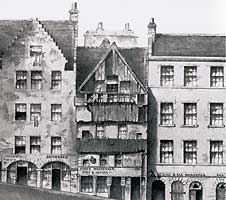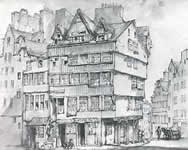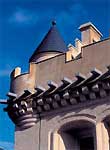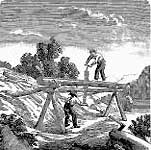Timber cladding in Scotland
The study outlines the development of timber cladding in Scotland, describes timber clad buildings in Scotland, and provides practical information on the use of timber cladding in Scotland.
Timber Cladding in Scotland
TIMBER CLADDING BEFORE THE INDUSTRIAL REVOLUTION
|
Many misconceptions surround the early history of building with timber in Scotland. The popular view is that masonry has always been the dominant walling material and that timber was used only for roofs, floors, stairs, internal partitions and finishings. While incorrect, this perception remains influential because of:
|
Engraving of Mahogany Land, West Bow, shows traditional timber construction of housing in Edinburgh's Old Town. |
- THE ROMANTICISM INTRODUCED BY WRITERS SUCH AS SIR WALTER SCOTT
Following the Union of the Parliaments in 1707, Scottish intellectuals began to search for a new national identity to re-assert 'Scottish-ness'. This gained impetus during the National Romantic Movement that swept Europe in the 19th century, with North Britain reverting to its earlier name of Scotland. Romantic writers such as Sir Walter Scott went out of their way to depict the Scots in a superior light by highlighting the considerable range of early stone structures whilst at the same time playing down the role played by more common building materials such as timber and earth. The inheritance of this view still continues, as is evidenced by the under-representation of timber buildings in recent histories of Scottish building.
Together, these three factors have created an historical fiction which, although frequently repeated, is nonetheless incomplete. Study of archaeological reports together with contemporary descriptions, images, documents, and modern survivals clearly demonstrates that timber is a central part of Scottish building tradition. The historical importance of timber construction in Scotland is not restricted to one area or one class of building but holds good for all types of structure throughout much of Scottish history. Even during the major masonry building period of the 19th century, large numbers of timber buildings continued to be built for a wide range of purposes.
|
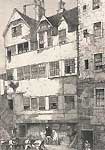
|
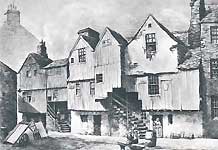
|
West Bow, Lawnmarket, Edinburgh. |
Milne's Court, Lawnmarket, Edinburgh. |
Wooden gallery on a house at 77 Saltmarket, Glasgow. |
SOURCES OF EVIDENCE FOR EARLY TIMBER CLADDING
Although timber structures in Scottish towns were clad in timber boarding until a very late date, this was often ignored in the late 19th and early 20th century when the surviving buildings were demolished. This is because the cladding was, at the time of demolition, generally covered with a lime render and it is this material that is most often recorded in contemporary descriptions and illustrations.
TIMBER CONSTRUCTION'S INFLUENCE ON THE AESTHETIC OF LATER MASONRY STRUCTURES.
Scotland is one of very few European nations where a distinctive national expression in masonry is based on earlier timber building traditions. The other obvious example is ancient Greece, where the Orders of Architecture developed in limestone and marble were based upon the arrangement of columns and entablature of earlier timber structures. By contrast, in Scandinavia, log construction was often roughened on the surface and pegged with dowels to provide a key for the hair-lime render used to make the log structure resemble ashlar masonry. This attempt to make a commonplace material look more expensive was the more normal approach. The evidence of timber architecture influencing the aesthetic of later masonry structures is everywhere in Scotland:
Pictish standing stones from the 8th and 9th centuries are clearly carved representations of basketwork structures. Rather than setting out the patterns geometrically, the sculptor carefully copied the basketwork prototype including the curves and offsets necessary to weave the patterns with willow rods; The aesthetic of cantilevered timber hoardings on top of early defensive walls is repeated later in the stone wall-walks and attic storeys of Scottish keeps and towerhouses; The jettying of floors, common in half timbered construction, is reflected in the corbelling of the face of masonry walls in towerhouses and tall 'lands'.
|
The resultant aesthetic, in which corbel courses ran across the facade in imitation of the jettying of timber floors and the castelated wall-walks imitated the hoarding at the top of castle walls, provided a distinctive signature to 15th and 16th century Scottish upper-class domestic architecture. Claypotts Castle, near Dundee took the corbelling even further by placing a rectangular attic over a three storey circular drum. ARCHAEOLOGICAL RECORDS Archaeological excavation is an important, but often fragmentary, source of information on timber building. Over archaeological timescales, timber tends to rot in the ground in all but the most waterlogged sites, and timber stains in the soil are very easily disturbed by subsequent building operations. Most urban sites undergo continuous redevelopment, and there is a considerable degree of luck involved for good evidence of timber to survive. DESCRIPTIVE DOCUMENTS Descriptions may incorporate inaccurate terminology and cannot always be taken at face value. Descriptive evidence always requires consideration in a wider context. In addition, the nature of the infill and/or cladding is often not specifically mentioned and needs to be inferred from the records of materials purchased to construct or maintain the building. |
Corbel courses run across the upper facade of Stirling Castle's Great Hall in imitation of the traditional jettying of timber floors. |
IMAGERY
Visual evidence for timber-clad buildings in Scottish towns survives in prints, drawings, paintings, book illustrations and architectural surveys. Lamb (1895) illustrates and describes a number of timber 'lands' surviving in Dundee until the 1890's (1), and the same type of evidence survives in other towns, for example in folios of drawings showing the streets and closes of Edinburgh (2,3,4,5). Unfortunately, whilst evidencing timber-fronted buildings, these drawings seldom show constructional details.
SURVIVALS
There is a broad relationship between the survival of buildings and their social status. High status buildings dating from the 14th century have survived in Scotland whereas surviving middle-status buildings from before the 16th century are rare, and few low-status buildings from before the 18th or even the 19th century still exist. Survivals are therefore an uncertain guide to building history, and are particularly unrepresentative of the lower-status buildings that, throughout history, formed the majority in Scotland's towns and countryside. Timber and earth were the two most common construction materials, and so the surviving buildings under-represent the amount of timber that would have been present. A further difficulty is that surviving timber buildings are generally entombed within later masonry walls and it is often impossible to investigate the timberwork without risking damage to subsequent layers of construction. Although there are no mediaeval timber-clad buildings surviving in Scotland in anything like intact form, it is possible to infer what such buildings might have looked like by examination of building survivals abroad:
-
TIMBER CLAD BUILDINGS IN THE LOW COUNTRIES OR NORWAY.
Because these were significant trading partners with Scotland, technologies and cultural ideas were often imported along with raw materials. The Bryggens area of Bergen in Norway still contains timber-clad buildings that were contemporary with this trade.
- BUILDINGS CONSTRUCTED ABROAD BY SCOTTISH ADVENTURERS AND ECONOMIC MIGRANTS.
Mediaeval Scotland was a poor country, and the lack of economic opportunity at home resulted in a considerable number of Scots emigrating to seek their fortunes in trade or military service. The Scots mercenary settlement at Gurro, Valle Cannobin, in the Piemonte region of Italy is a fascinating example of timber clad construction by Scottish emigrants.
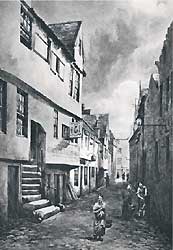
|
FACTORS IN THE EARLY DEVELOPMENT OF CLADDING Timber cladding in Scotland appears to have developed as the result of the constraints of the timber trade combined with cultural and economic forces: THE TIMBER TRADE WOOD PROCESSING Prior to the industrial revolution the wood-processing industry was entirely different to that of today. Logs were converted into beams and boards either by splitting, (either by cleaving the logs into thin boards with mallets and wedges or by squaring the logs into beams with axes and adzes) or by slowly, and with great effort, sawing the logs by hand using either a large pit- or frame-saw. Water-powered frame-saws were introduced in the Netherlands and Norway in the 1590's, and it is likely that they also appeared in Scotland around the same time. Thereafter, muscle-powered and water-powered sawing co-existed until the 19th century. TIMBER SUPPLIES Prior to the growth of rapid trans-Atlantic shipping in the 19th century, building timbers were restricted to locally available native species, or to timber that could be floated down major European rivers and shipped across the North Sea to Scotland. Large scale sawing of timber commenced in Amsterdam in the 14th Century and records exist of timber imports from this period onward. The two construction timbers in most common use were European oak and Scots pine. |
Surviving timber-clad buildings were often subjected to an external lime plaster in an effort to appease adjoining owners worried about the potential spread of fire. Fleshmarket Close, Edinburgh. |
|
EUROPEAN OAK (Quercus robur and Q. petraea) In mediaeval Scotland, as in much of Europe, oak was the preferred structural and finishing timber. Converted into boards by cleaving the log along its length, this technique required straight-grained and knot-free timber, with the board lengths determined by the distance between knots. The log was split into wedge-shaped segments, with the central core and sapwood removed (the width of each board had to lie within the radius of the log, making allowance for the removal of the centre of the log and the sapwood). It therefore required a log of at least 750mm (2ft 6in) diameter to produce a 300mm (1ft) wide board. Oak shingles appear to have been a popular roof covering on high-status buildings in Scotland until the late 17th century, and were produced by cleaving in the same way as boards (6). Scottish builders, in common with those in most parts of Europe tended to use cladding boards vertically. Each board was dressed to be roughly rectangular with a slight thinning to one side which was inserted into a check or groove in the thicker edge of the adjoining board. The oak available in Scotland appears to have been more knotty than English oak - in many of the illustrations of timber cladding, two lengths of board form a storey-height rather than the single length seen in European and English illustrations. Some of the architectural surveys that were occasionally undertaken prior to the demolition of a building describe oak cladding - in one Edinburgh example, a fragment of vertical boarding survived under a later lime render and was recorded in section by the surveyor. The boards vary in width from 150mm (6 inches) to 300mm (12 inches) and were 18mm (3/4 inch) thick at the widest part. |
|
|
|
Sawing logs by hand using a large pit-saw. |
Contact
Email: Central Enquiries Unit ceu@gov.scot
There is a problem
Thanks for your feedback
